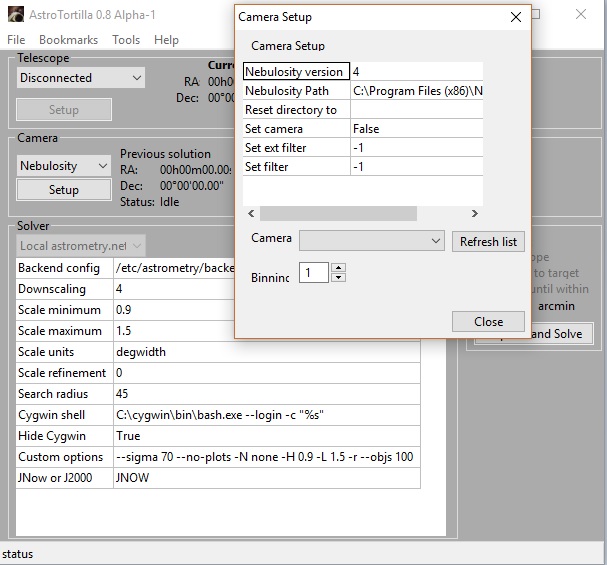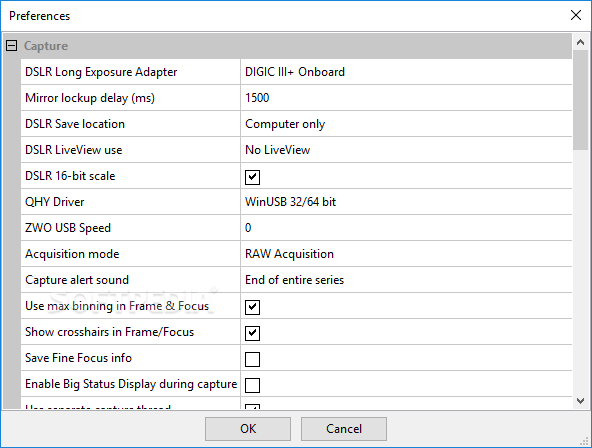Nebulosity 4 4 14
Nebulosity 4 Nebulosity is designed to be a powerful, but simple to use capture and processing application for Windows (7/8/10 32/64 bit) and OS X (10.7-14). A huge array of cameras are supported for capture (see below) and images from just about anything can be processed (support for many FITS formats, PNG, TIFF, JPEG, DSLR RAW files, etc). Scroll the list of applications until you find Nebulosity 4.1 or simply click the Search feature and type in 'Nebulosity 4.1'. If it is installed on your PC the Nebulosity 4.1 application will be found automatically. Notice that when you select Nebulosity 4.1 in the list of apps, the. I find it best to take darks throughout the imaging run (ie 4 the beginning, 4 after an hour and 4 at the end). That way the camera collects a good variety of data for Nebulosity to process. Scroll the list of applications until you find Nebulosity 4.1 or simply click the Search feature and type in 'Nebulosity 4.1'. If it is installed on your PC the Nebulosity 4.1 application will be found automatically. Notice that when you select Nebulosity 4.1 in the list of apps, the following data regarding the application is shown to you. The 4.4.3 version of Nebulosity is provided as a free download on our software library. Nebulosity belongs to Education Tools. The latest installer that can be downloaded is 57.5 MB in size. This PC program was developed to work on Windows XP, Windows Vista, Windows 7, Windows 8 or Windows 10 and is compatible with 32-bit systems.
A cluster of newborn stars herald their birth in this interstellar Valentine's Day commemorative picture obtained with NASA's Spitzer Space Telescope. These bright young stars are found in a rosebud-shaped (and rose-colored) nebulosity known as NGC 7129. The star cluster and its associated nebula are located at a distance of 3300 light-years in the constellation Cepheus.
A recent census of the cluster reveals the presence of 130 young stars. The stars formed from a massive cloud of gas and dust that contains enough raw materials to create a thousand Sun-like stars. In a process that astronomers still poorly understand, fragments of this molecular cloud became so cold and dense that they collapsed into stars. Most stars in our Milky Way galaxy are thought to form in such clusters.
The Spitzer Space Telescope image was obtained with an infrared array camera that is sensitive to invisible infrared light at wavelengths that are about ten times longer than visible light. In this four-color composite, emission at 3.6 microns is depicted in blue, 4.5 microns in green, 5.8 microns in orange, and 8.0 microns in red. The image covers a region that is about one quarter the size of the full moon.
As in any nursery, mayhem reigns. Within the astronomically brief period of a million years, the stars have managed to blow a large, irregular bubble in the molecular cloud that once enveloped them like a cocoon. The rosy pink hue is produced by glowing dust grains on the surface of the bubble being heated by the intense light from the embedded young stars. Upon absorbing ultraviolet and visible-light photons produced by the stars, the surrounding dust grains are heated and re-emit the energy at the longer infrared wavelengths observed by Spitzer. The reddish colors trace the distribution of molecular material thought to be rich in hydrocarbons.

The cold molecular cloud outside the bubble is mostly invisible in these images. However, three very young stars near the center of the image are sending jets of supersonic gas into the cloud. The impact of these jets heats molecules of carbon monoxide in the cloud, producing the intricate green nebulosity that forms the stem of the rosebud.
Not all stars are formed in clusters. Away from the main nebula and its young cluster are two smaller nebulae, to the left and bottom of the central 'rosebud,' each containing a stellar nursery with only a few young stars.
Astronomers believe that our own Sun may have formed billions of years ago in a cluster similar to NGC 7129. Once the radiation from new cluster stars destroys the surrounding placental material, the stars begin to slowly drift apart.
Revised list of Sir William Herschel's Fields of Diffuse Nebulosity

Abstract
William Herschel's catalogue of more than 2500 nonstellar celestial objects is without doubt one of the great astronomical achievements of this exceptional astronomer. Largely unknown, however, is a list containing fifty-two fields of extensive nebulosity, which Herschel published in 1811 as a supporting argument to his nebular hypothesis (Herschel, 1811: 275-276), all of which were observed as a by-product of his sweeps between 1783 and 1802. For the purpose of a final revision of Herschel's objects, his sister Caroline's copies of the eight observing books containing the results of his decade-long sweeps (Herschel, Herschel and Herschel, 2004) were analyzed. As a result, a number of errors and inaccuracies were found and corrected. Furthermore, the terminology used to describe the observed nebulosities--which differed widely from that used by Herschel to describe non-stellar objects in his better-known catalogues of nebulae--was investigated in order to obtain a clearer impression of the appearance of Herschel's objects. The resulting revised list, being one principal result of the review of Herschel's list of fifty-two nebulosities, contains corrected physical information on each of the nebulosities. It further gives estimates on the reliability of Herschel's observations and finally summarizes all of the noticed peculiarities in a separate column.
Nebulosity 4 Download
Nebulosity 4 4 14 Esv
- Herschel;
- Nebulosity